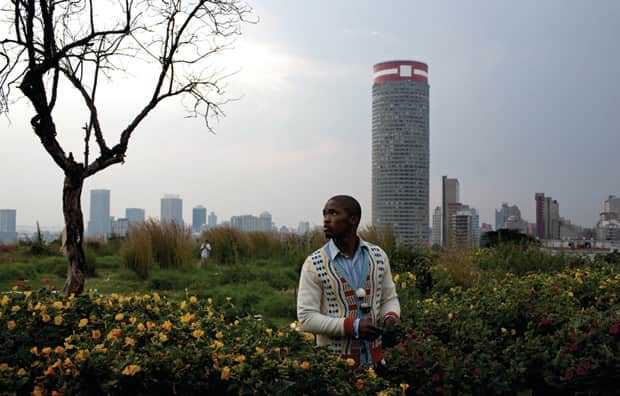 Most designers draw inspiration from a specific audience or muse, but for his new line of mens knitwear, Laduma Ngxokolo focused on a group dear to his heart, the Xhosa tribe of Port Elizabeth, South Africa. Having grown up within the community and gone through many of the traditional Xhosa initiation ceremonies himself, the 26-year-old Ngxokolo wanted to create a line that was contemporary but culturally and aesthetically appropriate. The result is a dynamic, vibrant group of knits that hold deep significance to the Xhosa people but appeal to non-locals as well. Just a month after winning top prize at the Society of Dyers and Colourists international competition in London, Ngxokolo started getting calls from buyers across Europe. And we’re pretty confident they’ll like him in the US, too.
Most designers draw inspiration from a specific audience or muse, but for his new line of mens knitwear, Laduma Ngxokolo focused on a group dear to his heart, the Xhosa tribe of Port Elizabeth, South Africa. Having grown up within the community and gone through many of the traditional Xhosa initiation ceremonies himself, the 26-year-old Ngxokolo wanted to create a line that was contemporary but culturally and aesthetically appropriate. The result is a dynamic, vibrant group of knits that hold deep significance to the Xhosa people but appeal to non-locals as well. Just a month after winning top prize at the Society of Dyers and Colourists international competition in London, Ngxokolo started getting calls from buyers across Europe. And we’re pretty confident they’ll like him in the US, too.
In what ways does the clothing line specifically relate to traditional Xhosa initiation ceremonies? Where I live, hundreds of boys between the ages of 18 and 23 attend a Xhosa circumcision ritual called Ulwaluko. [For this] they go to the school for about a month, but before they go, they have to give away all of their old clothes to their younger brothers and sisters, and their parents have to buy them a range of new clothes. Part of that new clothing range includes high quality men’s knitwear. The only knitwear styles that are available to buy are brands like Pringle and Polo—you know, conventional brands. As a person who has undergone the ritual, I felt I needed to change this to make it more suitable by incorporating traditional Xhosa aesthetics into the knitwear.
I read that your source inspiration is based on beadwork patterning. Yes, traditional Xhosa beadwork. Around the time I was doing the research, a local museum had a collection of beadwork on view [to attract tourists] visiting for the World Cup. I was very fortunate that it was available for me at this time, and that I was able to have pictures taken.
How did you translate the beadwork into a flat knitted pattern? The structure of beadwork is technically geometric and that kind of form is perfect for machine knitting. I took some motifs from the actual Xhosa beadwork, and I also developed my own motif, which I interpreted from the beadwork. I then knitted the patterns from these motifs. That was the conceptual part, and then, technically, I used South African mohair and merino wool.
Why did you choose those fibers specifically? Because they are high-quality fibers, which are suitable for buyers who want their knitwear to last long. My designs have been likened to art pieces, so I think it would be wise for them to be sustainable for the next generation.
Do you do the dyeing yourself? I actually buy the yarns in a natural color, then I bring them to a local dyer. The colors that are available are not part of my color palette, so I have to get them dyed before I knit the range.
Do you plan to distribute the range more widely? I have started establishing distribution communication with international buyers from Paris, Amsterdam and London. It’s been about a month now I’ve been in business, so to get that kind of response has been fantastic.
How has the response been within the Xhosa community? They were fascinated to see the designs become so popular [abroad]. I’d been producing the knitwear for a local store, but I’ve had to put that on freeze. I still let locals who are interested place orders so that I am able to serve them first, you know? Because some of them have been waiting years to get such a collection. They are very proud.
